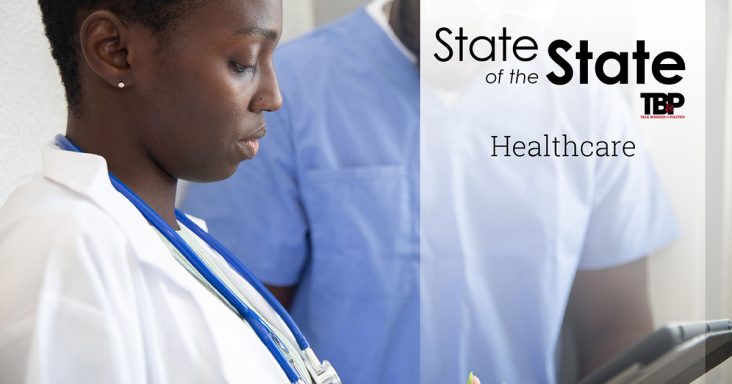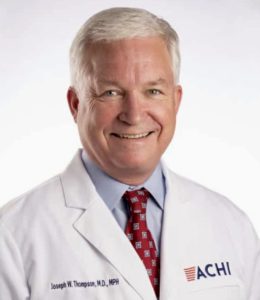State of the State Mid-Year 2024: Medical providers pinched by disparity in costs, payments
by September 9, 2024 1:58 pm 293 views

Arkansas health care providers are facing increasing costs without matching payment increases from government payers and insurance companies. It’s a major issue in a state that ranks near the bottom in maternal and infant mortality rankings.
Dr. Joe Thompson, president and CEO of the Arkansas Center for Health Improvement, a healthcare research and policy development organization, said the state is “still in a recovery mode from the acute effects of COVID.” Thompson was referring to inflationary pressures caused by the pandemic, when labor and supply costs increased dramatically. While hospitals are no longer relying on high-paid traveling nurses, the use of that resource during the pandemic has driven up labor costs for full-time staff.
At the same time, Medicaid, which serves primarily lower-income individuals, hasn’t increased payments, while Medicare, which serves older Arkansans, hasn’t increased them enough. Commercial insurance, the health care system’s other primary payer, is trying to limit reimbursement increases.
“So if your expenses have gone up a lot and your revenues haven’t changed, there’s a big pinch point going on,” he said.
Hospital finances have improved slightly, said Bo Ryall, president and CEO of the Arkansas Hospital Association. Of the state’s 70 acute care hospitals, perhaps 5-10 rural ones are in a tight spot financially. The larger ones are in better shape, but they are tapping into reserve funds.
“They’re not in danger of closing, but they are losing money at an alarming rate,” he said.
Ryall said the combination of rising costs and inadequate reimbursements are especially challenging for rural hospitals, which serve primarily Medicare- and Medicaid-funded patients. Those government programs reimburse at lower rates than commercial insurance does.

“So it’s what we would say is a math problem,” he said. “Costs are up here, revenues are down here, so until we can get revenues up to help that margin, it’s going to be tough for a lot of hospitals to make a margin.”
RECENT MEDICAID MOVES
Arkansas, like other states, has completed its Medicaid redetermination process now that the pandemic has ended. It and other states did not remove individuals from its Medicaid rolls during the pandemic. When the pandemic ended, it completed its process of determining eligibility over a six-month period.
Many beneficiaries were removed from the program because they did not submit the paperwork. Thompson said the dust has settled from that process, but providers say uncompensated care for uninsured individuals has increased.
Thompson said providers are considering how they can address these financial pressures. One way is negotiating with insurers for higher rates. If that occurs, the costs will get passed down to consumers. Providers also are looking to increase efficiencies by turning to outpatient therapies or ending some services.
Small hospitals that don’t deliver a lot of babies may have to consider closing their birthing units. In Arkansas, 56% of births are paid for by Medicaid, which reimburses at lower rates than insurance providers do. Meanwhile, independent physician groups, at least in urban areas, are becoming more tightly affiliated with larger hospital systems. Hospitals need providers, while the physician groups no longer find it as profitable to be independent.
HOSPITAL SURVIVAL ACTIONS
The challenging situation has led some hospitals to make other arrangements. In recent years, the Monticello hospital merged with the Baptist Health system, while the Fulton County hospital entered into a management agreement with Mountain Home-based Baxter Health.
Twenty-seven hospitals have converted to critical access hospital status, meaning they can have up to 25 beds but only allow patients to stay for three days in return for increased Medicare reimbursements. Five rural hospitals in Eureka Springs, Pocahontas, Osceola, Dewitt and Helena have converted to rural emergency status. Those offer only outpatient services and an emergency department in return for increased Medicare reimbursements. Ryall said a few more hospitals are considering converting.
Thompson foresees healthcare systems being increasingly at odds with Medicare Advantage plans, which are Medicare-funded health plans administered by private companies. The Centers for Medicare & Medicaid Services (CMS) is encouraging Americans to sign up for those plans, which reimburse providers at lower rates than traditional Medicare does. As a result, hospitals are having contract issues. Several California health systems have said they won’t participate in Medicare Advantage plans.
“I think you’ve got a pretty big and relatively invisible battle going on between CMS, the Medicare advantage plans, and those health care systems that are big enough to see the impact,” Thompson said.
PHYSICIAN SHORTAGE, MATERNAL HEALTH ISSUES
The supply of physicians remains an issue. The state now has three medical schools – the UAMS College of Medicine, the Fort Smith-based Arkansas College of Osteopathic Medicine, and the New York Institute College of Medicine in Jonesboro – so it’s producing more medical students. But a lack of Medicare-funded residencies has created a backlog, and now the state has become what Thompson described as a “net exporter” of new physicians.
Arkansas legislators have added some state-funded residencies, but more residencies are needed. Adding to the challenge is the fact that the state has one of the country’s lowest Medicare reimbursement rates, reducing doctors’ incomes and incentivizing them to practice elsewhere.
While hospitals and other medical providers in the health care system are dealing with financial challenges, the state also ranks near the bottom with regards to maternal and infant mortality rates.
Thompson said three factors are contributing to that reality. First, Arkansas is a rural state with only 36 licensed birthing centers, one of which is not providing services as it tries to recruit a physician. The Arkansas Center for Health Improvement reports that pregnant women in Arkansas traveled a median of 16 minutes for birthing services in 2022, but women in rural areas had to travel much farther. In Searcy County, the median was 73 minutes. Moms who are traveling farther to deliver babies are often obtaining less prenatal and postnatal care.
Second, many expectant mothers have risky pre-pregnancy health issues such as hypertension, diabetes and/or obesity. Finally, the state should do more to monitor mothers after delivery. Thompson said many problems can occur more than six weeks after the baby is born.
“For what should be a relatively healthy experience for most families, we’ve got some significant indicators, canaries in the coal mine, if you will, that we’re not achieving the best outcomes for what we can do,” he said.
Arkansas is one of four states that does not mandate coverage for Medicaid recipients for one year after delivery. Instead, coverage stops at 60 days. Of the three other states, Idaho and Iowa are planning extensions while Wisconsin is proposing a limited coverage extension, according to the KFF health policy research organization.
Gov. Sarah Sanders has resisted joining other states in extending Medicaid out to a year. Instead, she created the Arkansas Strategic Committee on Maternal Health to develop strategies for addressing the problem. Thompson said an alternative to extending Medicaid benefits would be transitioning new mothers to the state’s ARHOME Medicaid expansion program that uses federal dollars to provide private insurance.
“It would work, and it might even be to the benefit because in the Medicaid expansion, at least under the current version, those services are being paid for at commercial rates in the qualified health plans, not at the reduced rate in the Medicaid program,” he said. “But we’ve got to get the women covered, or nobody’s getting paid.”
Editor’s note: The State of the State series provides reports twice a year on Arkansas’ key economic sectors. The series publishes stories to begin a year and around mid-year to provide an update on the state’s economy. Link here for the State of the State page and previous stories.
